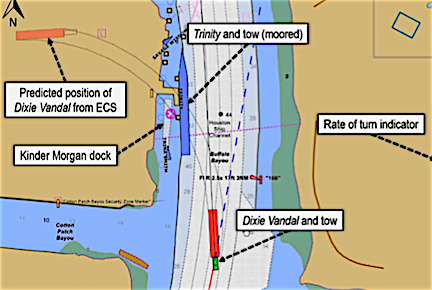The following is text of a marine accident brief from the National Transportation Safety Board (NTSB):
(WASHINGTON) — At 0408 local time on March 15, 2019, the towing vessel Dixie Vandal, pushing a partially loaded fuel barge upbound through the Houston Ship Channel, struck the towing vessel Trinity and one of its barges, which were moored and preparing to discharge cargo at the Kinder Morgan Pasadena Liquids Terminal in Pasadena, Texas. The contact caused Trinity and its tow to shift about 100 feet upriver, breaking the cargo hoses and mooring lines and damaging the facility. About a half-gallon of jet fuel discharged into the channel. No injuries were reported by the crew of five aboard Dixie Vandal nor by Trinity’s crew of four. Damage to the facility and barges amounted to $630,230.
Probable cause
The National Transportation Safety Board determines that the probable cause of the collision of Dixie Vandal’s tow with the moored Trinity and tow was the fatigued pilot falling asleep near the end of his 12-hour watch while maneuvering in the Houston Ship Channel, resulting in the loss of control of the vessel. Contributing to the pilot’s fatigue was the extended length of duty through the night and early morning hours and his use of an over-the-counter antihistamine.
Analysis excerpt
Dixie Vandal’s ECS playback displayed a course change to port about 04:07:30, a maximum rate of turn to port at 04:07:47, and a significant drop in speed at 04:08:35, indicating contact occurred between the vessels just over a minute after the course change. The pilot did not recall making this sudden course change nor did he recall hearing the BNWAS alarm on the bridge; after the accident, he told investigators that he believed he had dozed off. There was no evidence to suggest the system was deactivated or inoperable at the time of the incident. Based on testing of the crew five days before and after the incident, the system was likely operating as designed. Therefore, it is likely that the sensors detected motion in the wheelhouse just before the pilot fell asleep or while he was drifting off to sleep within the time frame of the setpoints of the BNWAS system, because the BNWAS system did not sound in the wheelhouse nor did the general alarm sound throughout the vessel before the collision.
Click here to read the complete report.

